
Wait a moment, weren’t we just here yesterday? Well, no. This is Walnut Canyon National Monument east of Flagstaff, but as we pulled up to the pay station, the park didn’t open for another 30 minutes. So, we turned around to check out the dirt road we passed, probably less than a quarter mile behind us which leads to the trailhead for the AZT, a.k.a. Arizona Trail. A couple of miles in, an oncoming bicyclist waved at us in a way that said, “Wait a sec.” He informed us we might want to think twice about driving down the hill as the road is rocky, and beyond that, it’s quite rutted. We immediately pulled over and continued on foot. He was right about the road condition, and it turned out that the trailhead was just past that stuff.

On the trail information panel, we saw a number of spurs, but it was the Walnut Creek via AZT Walnut Canyon Trail that caught our eye. Only five miles with the promise of seeing lots of horny toads. OK, I just made that up, but sure enough, we saw more than a few of these horned lizards.
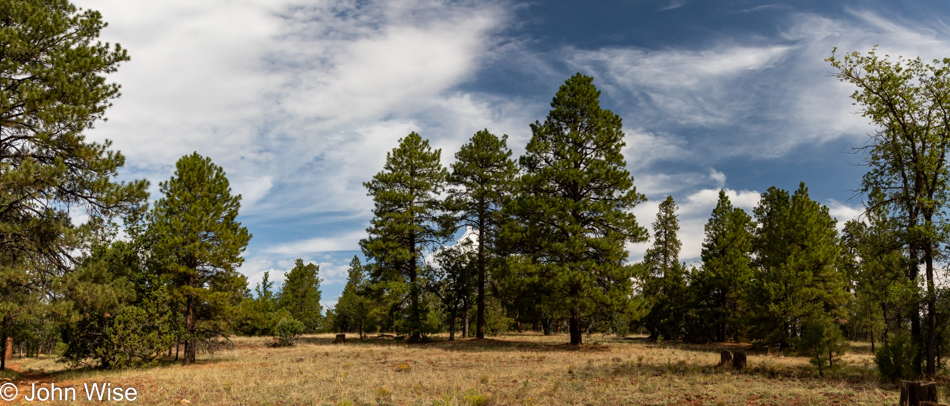
Maybe it’s because we are only 40 miles (64km) east of yesterday’s trail (except that was in the Kaibab National Forest and today, we are in the Coconino National Forest), but things look quite similar.

So, I will have to find what’s different.

Hmmm, she seems about the same as not always, but certainly of recent.

Okay, narrow cliffside trail using switchbacks to descend into a canyon; this is different.

Oh, a giant swallowtail butterfly; we didn’t see any of those yesterday.

After hiking to a low point on the trail, we started climbing again, and while there were plenty of other photos of the trail that probably warranted sharing, we still have more than a dozen images that I’m posting below about the second adventure we’ll be enjoying today.

The trail we are on is well-marked and well-defined, likely due to the fact mountain bikers enjoy the same path. I give it to those on bicycles out here as there are some spots where their vantage point so high above my own view triggers a good amount of respect in me for how close they are to some precarious edges.

There’s not a particularly great clearing at the end of the trail for a view into the canyon…

…the best we can do is grab a view here and there through the trees.

Caroline was admiring these flowers and so at a moment, I hoped she hadn’t noticed I took this photo for her. The plant is known as purshia but is also sometimes called bitterbrush or cliffrose.

This trail is not a loop; it is an out-and-back, and so on the way we came, we return.
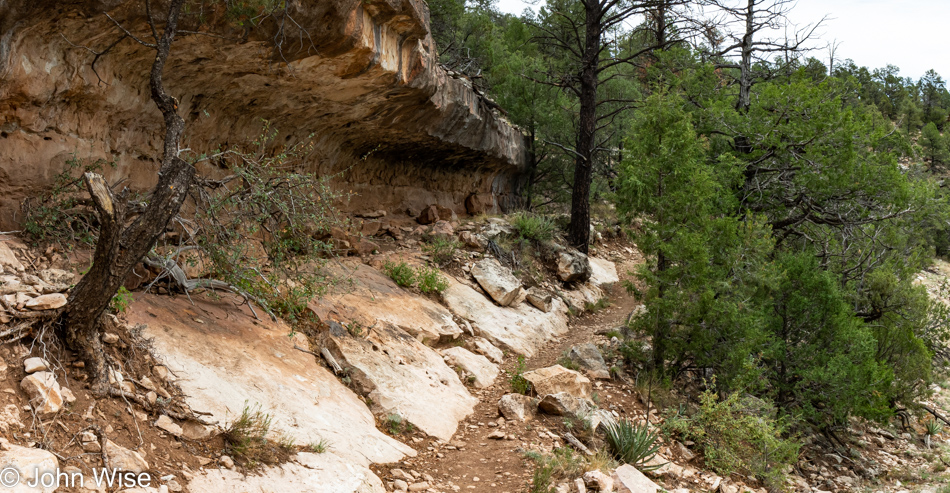
When we left Williams this morning, the weather forecast predicted a 15% chance of rain starting around 5:00 this afternoon, but here we are, approaching noon, and the dark clouds carrying the rumble of thunder are just behind us, spurring us along.

Just as quickly as the threat of rain came up, it passed, and after returning to the car, we drove into the National Monument itself and found ourselves on the short 1-mile Island Trail.
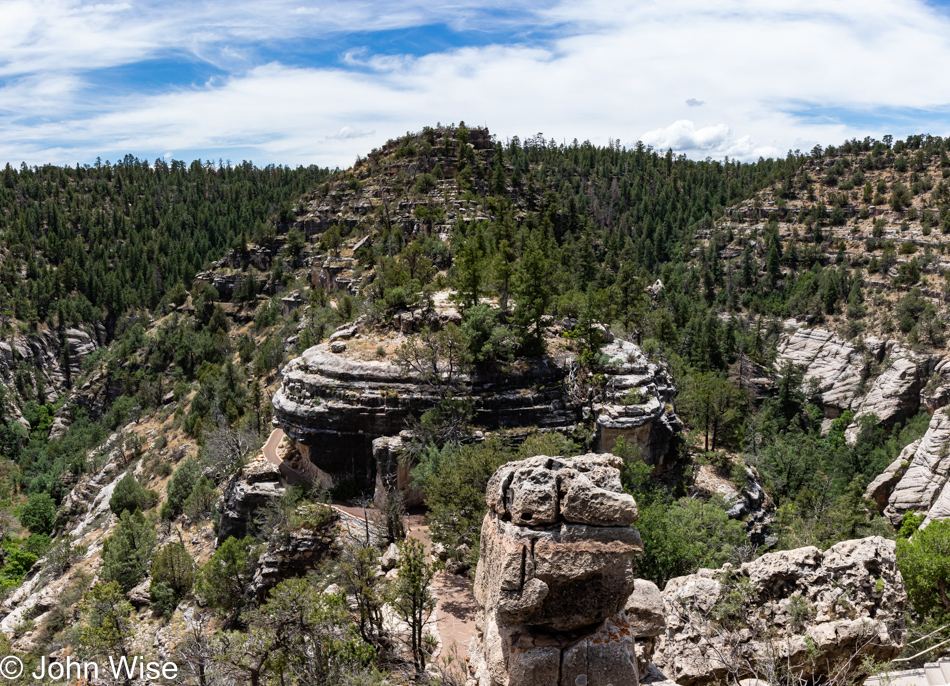
Apparently, it’s been close to 20 years since we were last here at Walnut Canyon National Monument, though as I continue working through our old photos, I have the feeling I might stumble into a directory that documents a visit up this way since then, but who knows?

The descent to the Island Trail is 185 feet or 17 stories, but listening to those climbing the stairs, you’d think they were trudging their way out of the Grand Canyon. I know I’m fat, old, and highly opinionated, but just how out of shape are these people bragging about how tough the trail is and that they hope we have plenty of water (we had left it in the car)? Not that I would advocate that any of these other visitors do the same, but Caroline and I know where we are, and we had decided to suck down nearly a liter each before we left the car, so we feel well prepared for a short hour-long hike.

This afternoon has us walking in the shadows of the Sinagua people. Sin is Spanish for “without,” and agua means “water.” After living in these alcoves for about 125 years, they left. We are fortunate to have the ruins that still exist here as, according to one of the placards along the trail, early visitors were not discouraged from taking souvenirs, and so in their efforts to discover what they could, some of the dwellings were disassembled and pillaged while cliffsides were dynamited in the same effort.

Well, no crying over that spilled milk as it was a little over 100 years ago after visitors out west were busy destroying these old dwellings that Walnut Canyon was first declared a national monument, and then in 1934, the National Park Service brought these lands into their care to try stemming our carelessness. Now consider something: my paternal grandfather would have been two years old when Walnut Canyon became a national monument, and it was only 88 years ago when it started receiving proper protection; he would have been 17 by then and could have been one of the collectors/marauders. Think about it; it’s not all that long ago, and then consider our present bias that suggests that somehow we could never be that culturally oblivious, and yet, look at where we are regarding the mediocrity we are wallowing in and the abundance of stupidity we hold dear.
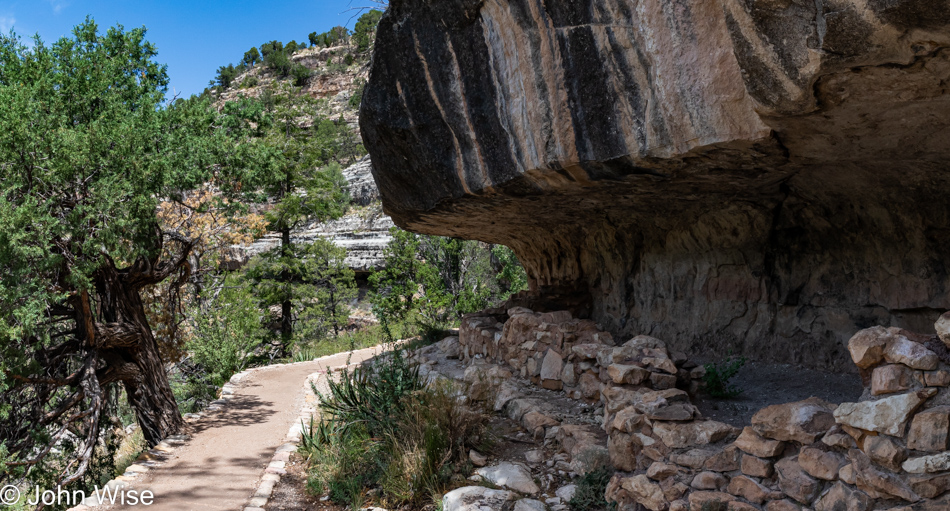
The struggles of people who lived in this canyon likely had to do with real issues such as the availability of food, water, and aggressors who might want their homes and compare that to our whining about gas prices, the personalities of feeble leaders on both sides and our inability to demand any responsibility of people exercising their right to be as stupid as they want to be, including ourselves.

Damn, I’m ranting again. Calm down, John; take some deep breaths and try to hear the faint echoes of people living in this canyon 1,000 years ago. Honor those who built this and called places like this home instead of ransacking everything in sight, adding false value to people’s perception of wealth. I really seem to be stuck on channel rant.

The parking lot was nearly full; there were people everywhere. From the Island Trail, we heard the voices of kids and adults, and then, in a moment, everyone disappeared and went silent. I refuse to believe there was a sudden flash of maturity and respect for others of those out here with us today, so it could only be that the ancient souls of the Sinagua people felt our need to connect with their ancestral village and pushed the irreverence to the edges where they wouldn’t intrude upon us. Yep, that’s more likely than conscious decisions by oafish dolts with their half-wit families playing that they’re at Disneyland.
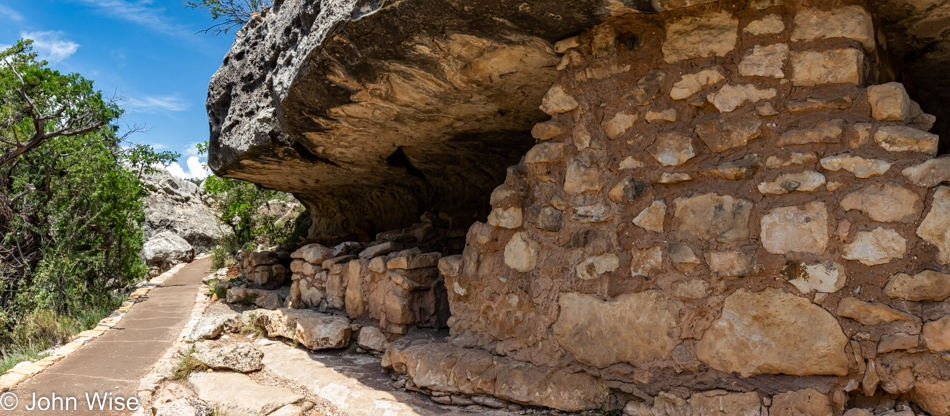
As I said, everyone else disappeared, and for a good while, this was all ours to take in.

These 275 million-year-old petrified sand dunes from what was once a desert reflect a cross-bedded appearance due to the dominant direction of the winds and how they changed over time. Above this Coconino Sandstone is a layer of the softer Toroweap Formation (shales from a calm sea), which allowed the Sinagua to build their home below the much harder Kaibab Limestone that acted as the natural roofs to their dwellings. A genius relationship where geology played a big role in offering shelter. By the way, these three layers are the top three layers at the South Rim of the Grand Canyon, too.

Carbon from fires within these dwellings still exists on some of the walls.
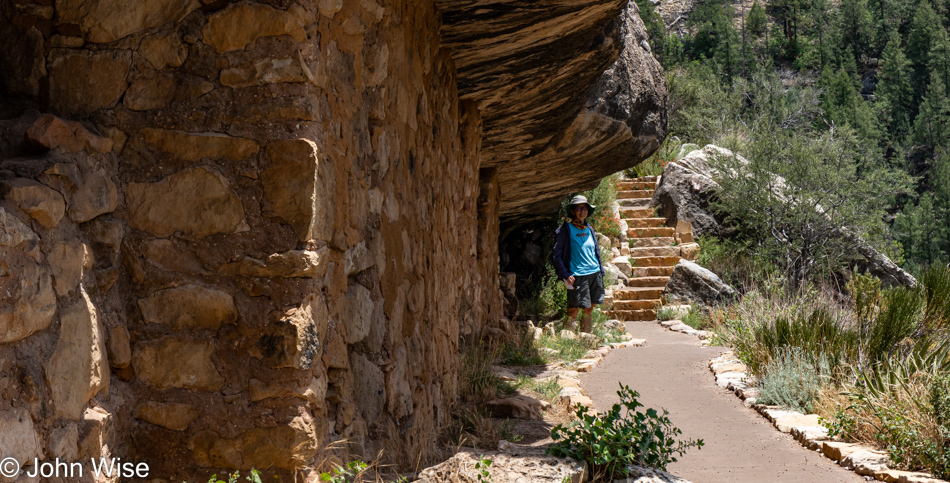
Yep, we are still alone down here, though we can hear voices from around the corner.

Moving toward the exit.

Look closely; there are eight people on the trail back up the cliffside, and to the left top, you can see the roof of the visitors center.

Of the over 80 dwellings in Walnut Canyon, we are lucky if we can spot all 25 that are visible from the trail.

When we reach the car, after a quick visit to an old pueblo and pithouse, we are approaching 10 miles of hiking for the day, and we are hungry. I have a hankering for a patty melt, and so we Google that. The results don’t feel trustworthy, but it’s all we have, so we head to the place with a 4.9-star rating and hope for the best. Over on old Route 66 is this small place called Proper Meats + Provisions; good luck finding parking, but if you do, you are in for an amazing surprise. Today, we had the greatest patty melts of our lives; they were that good. Time for a coffee and the two-hour drive home.